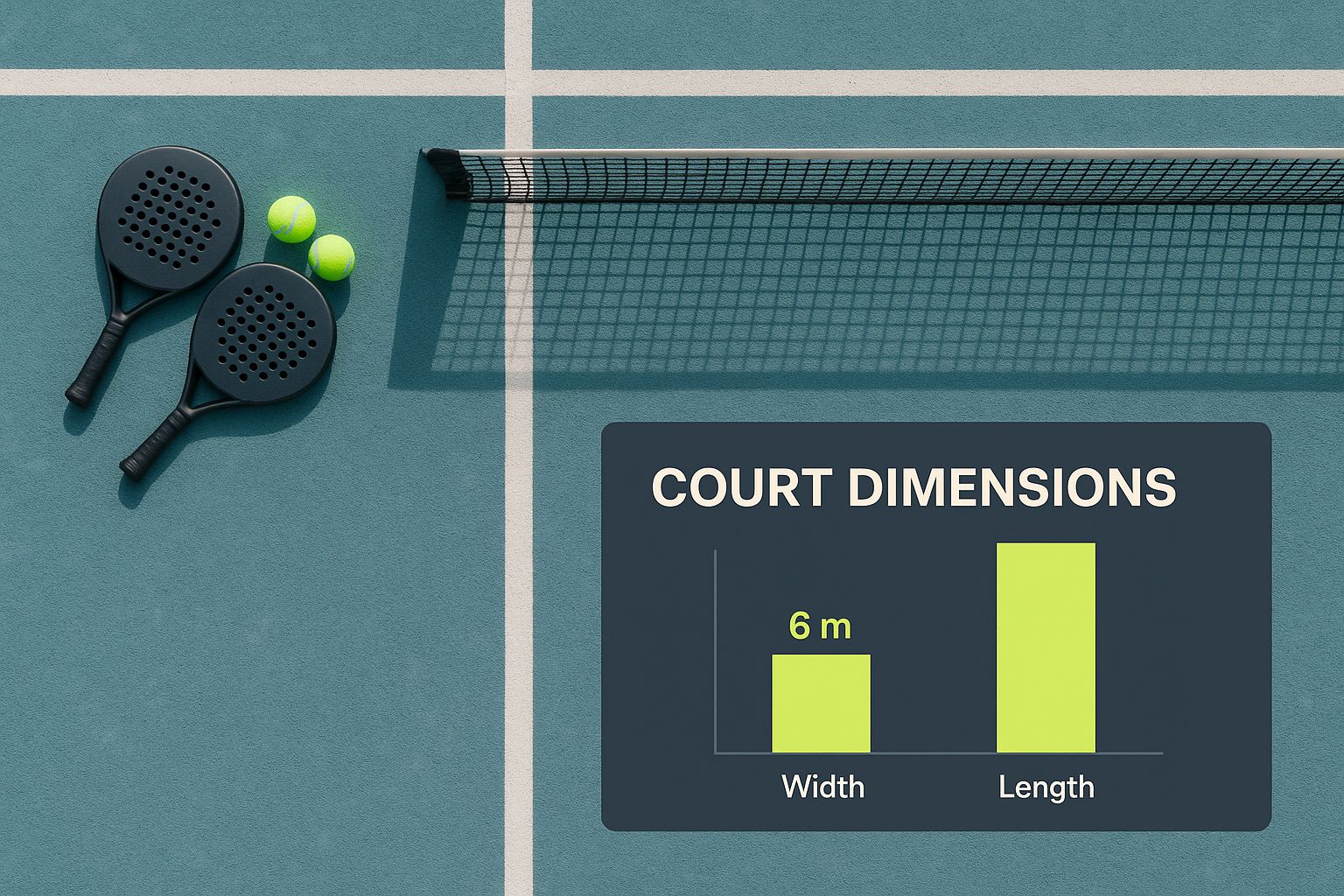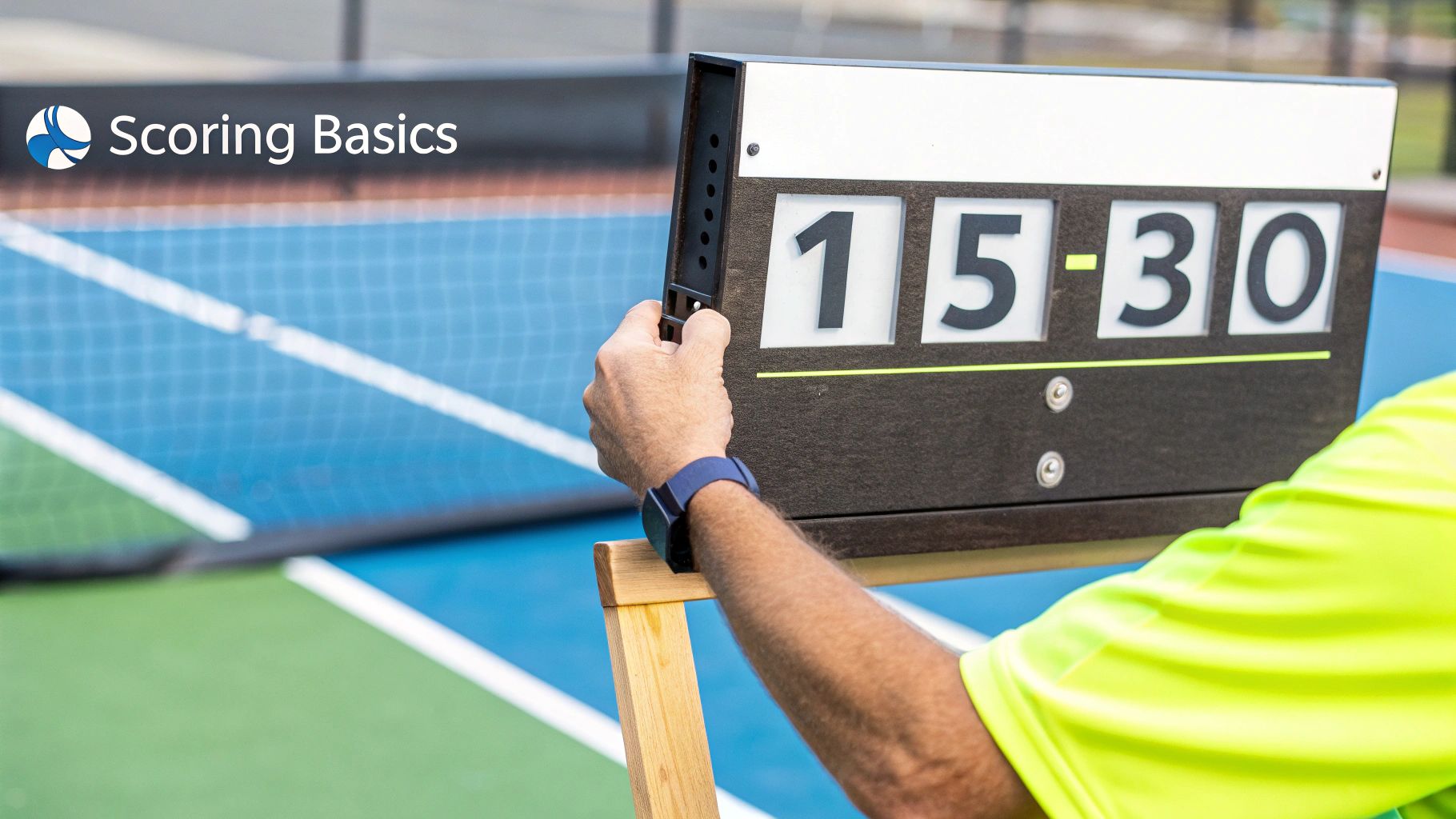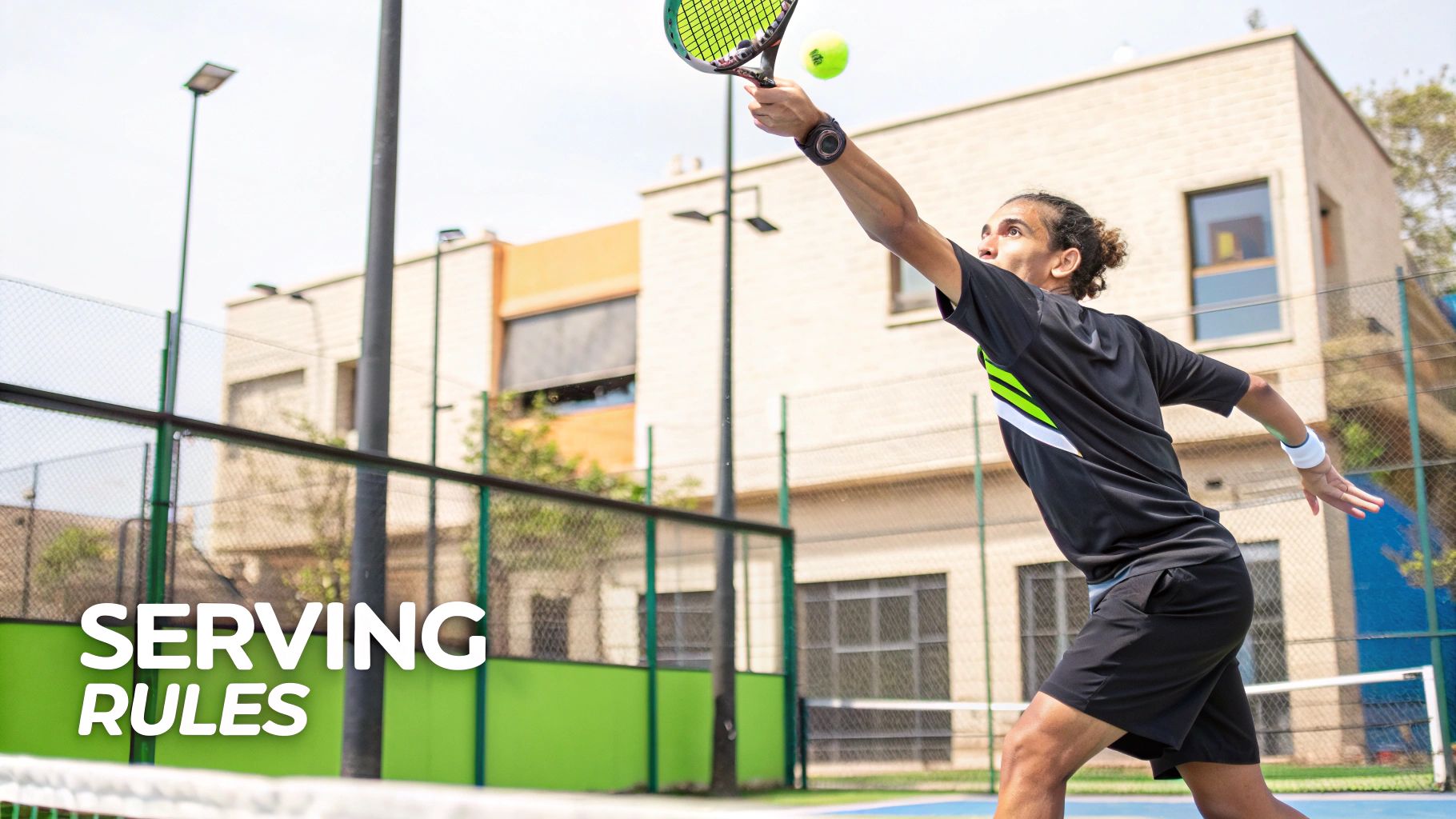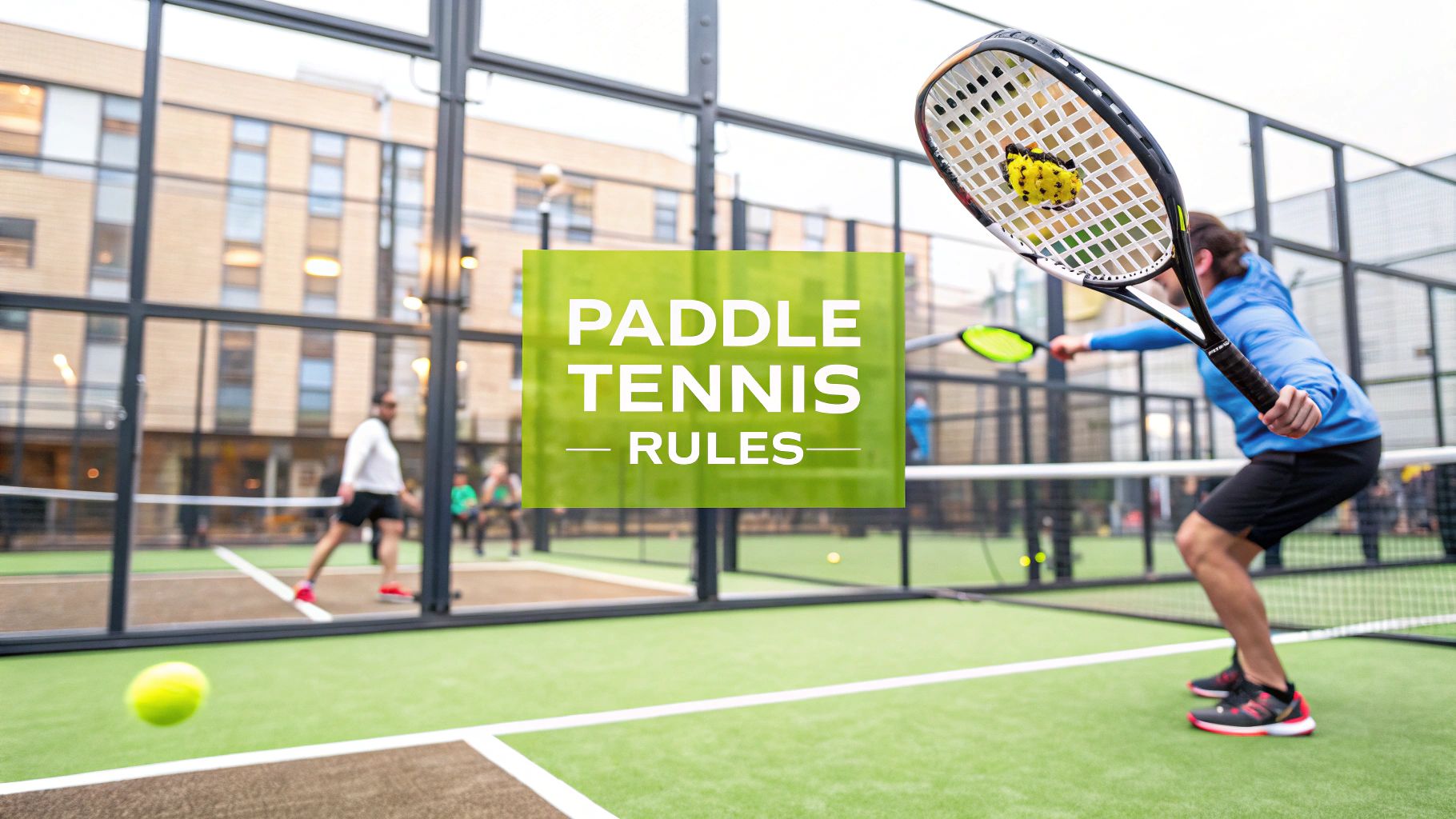Padel tennis is a fast-paced, doubles-only game where the walls are your best friend. The basic idea is pretty simple: get the ball over the net so it bounces once on your opponent's side, and do it in a way they can't legally hit it back. You can use direct shots or even let the ball ricochet off the glass walls to keep the rally going. Scoring is just like tennis—you play for points that go from 15, 30, 40, to Game.
Your First Step Onto the Padel Court
So, you're ready to jump into the world of padel? Awesome. Think of it as a brilliant mix of tennis strategy and the non-stop, wall-bouncing action you see in squash. At its core, padel is a social sport, always played in doubles on a court that’s about 25% smaller than a tennis court. That smaller space and the surrounding walls make for some seriously fun rallies and demand real teamwork.
The main objective is to win points with your partner. You do this by hitting a low-pressure ball over the net, making sure it bounces on your opponents' side of the court. If they can’t return it legally—maybe they hit it into the net, knock it straight out of the court, or let it bounce twice—the point is yours.
The Walls Are Your Friend
The glass and mesh walls are what really make padel a unique beast. In tennis, if the ball hits the back fence, the point is over. Not here. In padel, those walls are a massive part of the game. After the ball bounces once on the court, you can actually let it hit the back or side walls and then play your shot.

Buy the best padel gear to level up your next game!
CHECK OUT this deal from Padel Market!Get ready to take your game to the next level with the latest padel gear from Padel Market! Fast EU and Worldwide Shipping
This opens up a whole new world of strategy. You can turn what looks like a lost cause into a killer offensive shot. Learning how to read the ball off the glass is one of the first big skills you'll develop, and it's what separates the beginners from the seasoned players.
New players often treat the walls like they're out of bounds. Big mistake. Start thinking of them as your secret weapon—a way to buy yourself more time, change up the pace, or hit a shot from an angle your opponents will never see coming.
The Core Principles of Padel Gameplay
Before we get into the nitty-gritty of the specific paddle tennis rules—like serving, scoring, and all the different faults—let's lock in the basic concepts. If you get these down, everything else will make a lot more sense.
- Doubles Format Only: Padel is strictly a four-player game, with two on each team. This means communication and smart positioning with your partner are everything.
- The Single Bounce Rule: This is the golden rule. The ball can only bounce once on your side before you have to hit it. No exceptions.
- Underhand Service: Every serve has to be hit underhand. You'll bounce the ball once behind the service line and make contact at or below your waist.
- Walls Are In Play (After the Bounce): The ball is live after it bounces off any of the glass walls, but remember, it has to hit the court surface first.
These fundamentals are the heart and soul of padel. As we walk through everything from court dimensions to how a match is structured, you'll see how these simple ideas come together to create the addictive, high-energy game that millions are falling in love with.
The Court and Gear: Your Padel Essentials
Before you can even think about serves and killer rallies, you have to get to know your playground and your tools. The rules for the padel court and the gear aren't just technical details; they’re what make the game so addictive, fast, and strategic. Padel isn't tennis—the action is boxed in by walls, which turn what would be out-of-bounds shots into thrilling new opportunities.
A regulation padel court is a rectangle measuring 20 meters long by 10 meters wide, which is quite a bit cozier than a tennis court. This smaller space is no accident; it’s designed to speed up reaction times and encourage longer, more tactical rallies. A net splits the court in half, standing 88 cm high at its center. The whole thing is enclosed by a mix of glass walls and wire mesh, which aren't just there to keep the ball from flying away—they're an active part of the game.
The Anatomy of the Padel Court
The court’s design is what really sets padel apart. The back walls are almost always made of tempered glass, which gives you a clean, predictable bounce. As you move up the sides of the court, the glass gives way to a metallic mesh fence. Getting a feel for this is crucial, because a ball ricocheting off the mesh is a completely different beast than one coming off the glass.
These dimensions are the same everywhere, which has been a huge factor in the sport's incredible growth. Having standardized rules means players get a consistent experience no matter where they play. The International Padel Federation (FIP) notes that this uniformity has helped padel explode to over 30 million players across more than 130 countries.
Take a look at the diagram below for a bird's-eye view of a standard court layout.

You can clearly see the service lines and center line that create the zones you need for serving and general play.
Choosing Your Padel Racket and Ball
Once you've got the court down, it's time to talk gear. The padel racket, or "pala," is a totally different experience if you're coming from a stringed racket background. It’s a solid, stringless paddle riddled with holes to cut down on weight and air resistance. This design offers a unique feel that’s a world away from tennis. If you're curious about the specifics, we break down the key differences between padel and tennis in another guide.
Palas are typically made from materials like carbon fiber or fiberglass, with a foam core inside. The type of foam determines how it plays—harder foams give you more power, while softer ones offer better control. The rules keep the dimensions in check so no one gets an unfair equipment advantage.
The ball is the final piece of the puzzle. It looks just like a tennis ball, but it's a touch smaller and has less internal pressure. This might sound minor, but it completely changes the game.
To help you keep track of all the official specs, here’s a quick-reference table.
Official Padel Court and Equipment Specifications
This table breaks down the official dimensions and key characteristics for the court, racket, and ball, giving you a clear look at how each element is designed to shape the game.

Buy the best padel gear to level up your next game!
CHECK OUT this deal from Padel Market!Get ready to take your game to the next level with the latest padel gear from Padel Market! Fast EU and Worldwide Shipping
| Element | Specification | Gameplay Impact |
|---|---|---|
| Court | 20 m x 10 m | Creates a compact, fast-paced playing area that encourages quick reflexes and strategic rallies. |
| Net Height | 88 cm (center) | The lower net height facilitates more aggressive, attacking net play and faster exchanges. |
| Pala (Racket) | Solid, stringless, perforated | The stringless design provides a unique blend of power and control, distinct from traditional racket sports. |
| Ball | Lower internal pressure than a tennis ball | Results in a lower, slower bounce, which extends rally lengths and emphasizes tactical play over raw power. |
These specifications are precisely calibrated to work together, creating the signature feel of padel.
The combination of the court, the racket, and the ball is what defines the unique rhythm of padel. The solid pala gives you that satisfying pop when you make contact, and the lower-pressure ball encourages you to build points with patience and strategy. Getting a handle on these basics is the first real step to mastering the game and moving on to more advanced techniques.
Understanding Padel Scoring from Points to Sets
If you've ever watched or played tennis, you're already halfway there. The great news is that padel borrows its scoring system directly from tennis, so it feels familiar right from the first game. A match is simply a collection of sets, sets are made of games, and games are won by scoring points.

The point progression inside a game is identical: 15, 30, 40, and then the final point wins the Game. So, if your team snags the first point, the score is 15-0. Win the next one, and it's 30-0. This structure makes it super easy to follow along.
From Points to Games
Winning four points wins you the game, but there's a small catch. You have to win by a two-point margin. If the score gets locked at 40-40, you’ve hit a deuce, and the game goes into a tiebreaker phase. To break the deadlock, a team has to score two points in a row.
The first point after deuce gives that team the Advantage (often called "Ad-in" if you're serving, or "Ad-out" if your opponents are). Win the next point, and the game is yours. But if you lose it, the score snaps right back to deuce, and the battle for a two-point lead starts all over again.
Winning Sets and Matches
A standard padel match is played as the best of three sets. To claim a set, your team needs to be the first to win six games, and just like in a single game, you need to have a two-game lead. This means a set can wrap up with scores like 6-2, 6-3, or 6-4.
If the set score hits 5-5, the race is on to win the next two games and take the set 7-5. But what happens if it gets even tighter and the score ties at 6-6? This is where the real drama unfolds, triggering a set tie-break. It’s one of the many small but crucial regulations you can dive deeper into by reading up on the official rules of padel.
Key Takeaway: The scoring hierarchy is easy to remember. You win points to win a game. You win games to win a set. And you win sets (usually two out of three) to win the match.
Decoding the Tie-Break
When a set is deadlocked at 6-6, a special tie-break game decides the winner. Forget 15, 30, 40—the scoring here is just simple counting: 1, 2, 3, and so on.
Here’s how it works:
- First to Seven: The first team to score seven points wins the tie-break, but they must win by at least two points.
- Serving Sequence: The player who was next in line to serve kicks off the tie-break. They serve just one point, starting from the right side of the court.
- Rotation: After that first serve, the serve immediately flips to the opposing team. They serve the next two points, starting from their left side. This two-point serving rotation continues until a winner is decided.
- Winning the Tie-Break: A tie-break might end 7-3 or 7-5. If the score gets to 6-6, play continues until one team pulls ahead by two points (like 8-6 or 9-7). The team that wins the tie-break wins the set with a final score of 7-6.
The Exciting Golden Point Rule
To inject more sudden-death excitement and speed up matches, many modern tournaments and social games now use the "Golden Point." It’s a fast-paced alternative to the traditional deuce/advantage system.
When a game score reaches 40-40, it's all-or-nothing. A single, decisive point is played—the Golden Point. The receiving team gets to choose whether they want to receive the serve on the left or right side of the court. Whoever wins that one rally wins the entire game. This rule is a massive part of the professional circuit and keeps the energy of the game absolutely electric.
How to Serve and Return Legally
The serve is the one moment in padel where you have total control. In a game defined by chaotic, lightning-fast rallies, the serve is your chance to take a breath, aim, and dictate how the point begins.
Getting the legal serve right isn't just about avoiding a penalty; it’s your first strategic move to put your team on the front foot. Understanding the core paddle tennis rules for serving is the foundation of a confident and tactical game.

Don't think of the serve as a tennis-style power shot. It’s more like an opening move in chess. The real goal is to get the point started in a way that forces the receiver into a weak return, giving your team an easy put-away.
The Underhand Serve Motion
The single most important rule of the padel serve is that it has to be underhand. This is non-negotiable and what really separates it from tennis. Trying to hit a big, overhand serve is an instant fault.
The correct motion is a two-part sequence: you bounce the ball, then hit it at or below your waist. You have to let the ball bounce once on the ground behind the service line before you make contact. No hitting it straight out of your hand.
Key Rule Insight: The contact point is everything. Picture an imaginary line across your waist. Your paddle has to connect with the ball at or below that line. Hitting it too high is one of the most common mistakes new players make.
Step-By-Step Guide to a Legal Serve
To nail a legal serve every single time, just follow this simple checklist. Breaking it down into small steps makes it much easier to remember when you're under pressure on the court. For an even deeper dive into the basics, check out our guide on how to play padel for beginners.
- Get in Position: Stand with both feet completely behind the service line. You'll start the game on the right side of the court, serving diagonally into your opponent's right-side service box.
- Bounce the Ball: Let the ball drop and bounce once. This bounce has to happen behind the service line.
- Strike Below the Waist: As the ball comes up from the bounce, hit it with an underhand motion. Make absolutely sure the contact point is at your waist or lower.
- Aim Across the Court: Your serve needs to fly over the net and land inside the diagonally opposite service box without touching anything on the way.
Understanding Service Faults
Just like in tennis, you get two cracks at the serve. If you mess up the first one, it's called a fault, and you get a second try. Botch the second one, and it's a double fault—you lose the point.
These are the most common service faults you need to watch out for:
- Foot Fault: One or both of your feet touch or step over the service line while you're serving.
- Missing the Bounce: You hit the ball out of the air before it has bounced. Always a fault.
- High Contact: You strike the ball above your waist.
- Missed Box: Your serve lands anywhere outside the correct service box. Hitting the line is in, but anywhere else is out.
- Hitting the Fence: If your serve lands in the correct box but then bounces into the wire mesh fence, it's a fault.
The Let Serve What It Means
A "let" is basically a do-over. This happens when your serve clips the net but still lands in the right service box. When the umpire calls a let, the serve doesn't count, and you just replay it—whether it was your first or second attempt.
But be careful: if the ball hits the net and then lands outside the service box, it's not a let. It's just a regular fault.
Mastering Rallies and Wall Play
Once the serve is in, the real fun begins. This is the heart of padel—where strategy, lightning-fast reflexes, and teamwork collide in an electrifying rally. Forget the stop-and-start feel of other sports; a padel rally is a constant flow of movement and quick thinking, where the walls aren't just boundaries—they're your best friends.
The whole game hinges on one simple concept: the one-bounce rule. The ball can only hit the court once on your side before you have to send it back. If it bounces twice, you lose the point. This single rule sets the entire pace of the game, forcing you to be on your toes and ready for the next shot.
The Golden Rule of Wall Play
Here’s where padel really breaks away from any other racquet sport. After the ball bounces once on the ground, it's still completely in play if it hits any of the glass walls or even the metal fence. This isn't an "out of bounds" situation; it’s a fundamental part of the game's DNA.
Think of the walls as your second chance. A shot that looks way too fast or deep can be easily handled after it comes off the back glass. This gives you precious extra time to get into position and hit a much more controlled return. Learning to read the ball's angles and speed off the glass will completely change your game.
A classic beginner mistake is charging a deep ball head-on, only to watch it sail past. An experienced player does the opposite: they turn and run towards the back wall, knowing the rebound will set them up for a much easier shot.
Common Rally Scenarios
A rally can go a million different ways, but most points are built around a few core shots. Get these down, and you’ll start anticipating what your opponent will do next.
- Direct Volleys: This is your power play. You hit the ball out of the air before it ever bounces. It's an aggressive move, usually done close to the net to end the point with authority.
- Groundstrokes: The bread and butter of padel. You play the ball right after its first bounce. This is how you build a point, move your opponents around, and set up a winner.
- Playing Off the Back Wall: A defensive gem. You let a deep shot bounce, hit the back glass, and then play it as it comes back towards the net.
- Playing Off the Side Wall: Just like playing off the back, but this is your go-to for angled shots. The ball might bounce, hit the side wall, and pop out perfectly for you to return.
The rules are built to create a dynamic and inclusive game, which is a huge reason for its explosive growth. A perfect example is that roughly 40% of all padel players worldwide are female—a massive number for a racquet sport. The smaller court, lighter racquets, and focus on strategy over pure power levels the playing field for everyone. You can dive deeper into these fascinating stats on padel.fyi.
Unlocking the Contra Pared
One of the coolest shots in padel has to be the "contra pared," which means "against the wall." This is where you intentionally smash the ball against your own back wall to get it over the net. It's a last-ditch defensive shot you pull out when you're completely out of position.
It looks amazing when it works, but it's a high-risk, high-reward play. For it to be legal, the ball has to go from your racquet, to your wall, and then clear the net to land in your opponent's court—all without bouncing on your side first.
Rally-Ending Faults to Avoid
A rally ends one of two ways: with a winning shot or a silly mistake. While you’re hunting for winners, it's just as crucial to avoid giving away easy points. You lose the point if:
- Double Bounce: The ball bounces twice on your side. Game over for that point.
- Hitting the Net: Your return shot doesn’t make it over the net.
- Ball Hits a Player: The ball hits you or your partner before bouncing.
- Touching the Net: You, your racquet, or your clothes touch the net or its posts while the ball is live.
- Hitting Out of Bounds: You hit the ball directly into your opponent's walls or fence before it has bounced on their side of the court.
Get a handle on these rally dynamics, and you’ll unlock the strategic, addictive fun that makes padel so incredible.
Common Paddle Tennis Rule Questions Answered
Even the most seasoned players have moments on the court that make them pause. Padel's lightning-fast pace and unique wall play can create some tricky situations where you just have to stop and ask, "Wait, was that allowed?" Knowing the finer points of the paddle tennis rules is what really separates the good players from the great ones.
Think of this section as your quick-reference guide for those head-scratching moments. We've pulled together the most common questions and debates that pop up during a match to give you clear, straightforward answers. Let's clear up the confusion so you can get back to the game.
Can the Ball Hit the Fence After Bouncing?
Yes, it absolutely can. This is one of the core rules that makes padel so addictive. Once the ball bounces on your side of the court, it can then legally hit the wire mesh fence or any of the glass walls. After that, it's live, and you can play it back over the net.
Just think of the walls and fence as part of the playing surface after that first bounce. The game is designed to keep rallies going and reward smart court positioning.
But remember, the order here is everything. If the ball smacks the fence or a wall before it bounces on the ground, the point is immediately over, and your team loses it. That's a classic mistake for players new to the game.
What Happens If the Ball Hits a Player?
This one is black and white, with no room for debate. If the ball hits you or your partner at any time during a rally, your team loses the point. It doesn't matter where you are, if it was an accident, or how fast the ball was going.
This rule comes into play in two main ways:
- On the fly: If your opponent's shot hits you or your partner directly before it has a chance to bounce, they win the point.
- Off the wall: If the ball bounces on your side, comes off the back glass, and then hits a player, the team of the player who got hit still loses the point.
The big idea here is that the ball can only be played with the racket. Your body is never a legal way to return a shot. This rule keeps players safe and makes sure the game is about skill with the pala.
It's a great reminder of why court awareness and footwork are so critical. You always have to be ready to get out of the way, especially when a powerful shot is coming off the glass.
Can I Reach Over the Net to Hit the Ball?
This is a great question, and the answer is yes… but only in one very specific scenario. You can reach over the net to hit the ball as part of your follow-through only if the ball has already bounced on your side and is on its way back to your opponent's court.
You'll usually see this happen with a tricky drop shot hit with a ton of backspin. The ball might land softly on your side and then, because of the spin, start bouncing back over the net. If that happens, you are allowed to reach across the plane of the net to play the ball and win the point.
However, there are two huge "buts" you need to know:
- You are never allowed to touch the net, the posts, or any part of your opponent's court. If your racket, clothes, or body makes contact, you lose the point instantly.
- You cannot hit the ball while it is still on your opponent's side of the court. It must have crossed over to your side first.
Can My Partner and I Switch Sides During a Point?
Yes! Not only can you, but you absolutely should. Once the serve has been successfully returned, you and your partner have complete freedom to move anywhere on your side of the court. Padel is an incredibly fluid game, and sticking to rigid positions is a recipe for disaster.
After the return, all fixed positions are gone. You can switch sides mid-rally, have one player crash the net while the other hangs back, or both play deep to defend a lob. It's all about adapting your strategy to what's happening in the point.
The only time your positions are locked in is during the serve. The server has to serve from their designated side for that specific point, and the receiver must be standing diagonally across from them. As soon as that ball is in play, it’s a free-for-all, and the best teams are the ones who move together like a well-oiled machine.
Ready to put these rules into practice? At Padel Rumors, we've got everything you need to elevate your game, from in-depth guides and gear reviews to the latest news from the professional tour. Find your next racket or discover a court near you at https://www.padelrumors.com.










